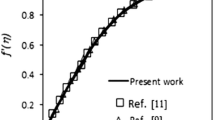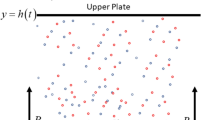Abstract
The steady two-dimensional, laminar, viscous, incompressible boundary layer flow of Cu/Ag-H2O nanofluid in a diverging channel formed by two non-parallel walls in a Darcian porous medium is numerically studied in the presence of mass suction/injection of equal magnitude on both the walls. Here, divergent flow is generated by a line source of fluid volume at the intersection of channel walls. Using similarity transformations, the non-linear governing PDEs are transformed into self-similar coupled non-linear ODEs and they are solved numerically with the help of MATLAB-built solver “bvp4c”. The conditions for the existence of boundary layer flow structure for nanofluid through divergent channel in porous medium are obtained. The analysis reveals that when the permeability parameter \(K\) and nanofluid-volume-fraction-related parameter \(\phi_{1}\) are chosen in a specific manner such that they satisfy the condition \(K > 2\phi_{1}\) then boundary layer flow exists, preventing separation for any mass suction/injection or even in the absence of mass suction/injection. A similar velocity field rises with permeability parameter, which exhibits opposite behavior with nanoparticle volume fraction. Also temperature increases with nanoparticle volume fraction, permeability parameter, and Eckert number, and decreases with power-law exponent (related to variable wall temperature). Skin-friction coefficient and heat transfer rate for Cu-water nanofluid are stronger when compared with Ag-water nanofluid.


















Similar content being viewed by others
References
Choi S U S 1995 Enhancing thermal conductivity of fluids with nanoparticles. In: Siginer D A and Wang H P (Eds.) Developments and Applications of Non-Newtonian Flows. New York: ASME, vol. 66, pp. 99–105
Sheikholeslami M, Ganji D D, Ashorynejad H R and Rokni H B 2012 Analytical investigation of Jeffery-Hamel with high magnetic field and nanoparticle by Adomain decomposition method; Appl. Math. Mech. 33(1) 25–36
Usman M, Haq R U, Hamid M and Wang W 2018 Least square study of heat transfer of water-based Cu and Ag nanoparticles along a converging/diverging channel; J. Mol. Liq. 249 856–867
Biswal U and Chakraverty S 2020 Investigation of Jeffery-Hamel flow for nanofluid in the presence of magnetic field by a new approach in the optimal homotopy analysis method; J. Appl. Comput. Mech.. https://doi.org/10.22055/jacm.2020.31909.1937
Azimi M and Riazi R 2016 MHD copper-water nanofluid flow and heat transfer through convergent–divergent channel; J. Mech. Sci. Technol. 30(10) 4679–4686
Akinshilo A T, Ilegbusi A, Ali H M and Surajo A J 2020 Heat transfer analysis of nanofluid flow with porous medium through Jeffery-Hamel diverging/converging channel; J. Appl. Comput. Mech. 6(3) 433–444
Alsabery A I, Chamkha A J, Saleh H and Hashim I 2017 Natural convection flow of a nanofluid in an inclined square enclosure partially filled with a porous medium; Sci. Rep. 7 2357
Jeffery J B 1915 The two-dimensional steady motion of a viscous fluid; Philos. Mag. 6(29) 455–465
Hamel G 1916 Spiralförmige Bewegung zäher Flüssigkeiten; Jahresber. d. Dt. Mathematiker-Vereinigung 25 34
Pohlhausen V E 1921 Berechnung der Eigenschwingungen statiisch besiimmter Fachwerke; Z. Angew. Math. Mech. 1(1) 28–42
Millsaps K and Pohlhausen K 1953 Thermal distributions in Jeffery-Hamel flows between non-parallel plane walls; J. Aeronaut. Sci. 20 187
Harrison W J 1919 The pressure in a viscous liquid moving through channel with diverging boundaries; Proc. Cambridge Philos. Soc. 19 307–312
Tollmien W 1921 Gnenzschichtheoric Handbuch der Experimental Physik; Akadeneisahe Verlagsgesellschaft 4(1) 241
Noether F 1931 Handbuch der Physikalischen und Technischen Mechanik. Leipzig: J. A. Barch, vol. 5, p. 733
Dean W R 1934 Note on the divergent flow of fluid; Philos. Mag. 7(18) 759–777
Bhattacharyya K and Layek G C 2011 MHD boundary layer flow of dilatant fluid in a divergent channel with suction or blowing. Chin. Phys. Lett. 28(8): 084705.
Dogonchi A S and Ganji D D 2016 Investigation of MHD nanofluid flow and heat transfer in a stretching/shrinking convergent/divergent channel considering thermal radiation; J. Mol. Liq. 224 592–603
Mohyud-Din S T, Khan U, Ahmed N and Bin-Mohsin B 2017 Heat and mass transfer analysis for MHD flow of nanofluid in convergent/divergent channels with stretchable walls using Buongiorno’s model; Neural Comput. Appl. 28 4079–4092
Rana P, Shukla N, Gupta Y and Pop I 2019 Analytical prediction of multiple solutions for MHD Jeffery-Hamel flow and heat transfer utilizing KKL nanofluid model; Phys. Lett. A 383(2–3) 176–185
Kumar K G, Rahimi-Gorji M, Reddy M G, Chamkha A J and Alarifi I M 2020 Enhancement of heat transfer in a convergent/divergent channel by using carbon nanotubes in the presence of a Darcy-Forchheimer medium; Microsyst. Technol. 26 323–332
Jungclaus G 1960 Two-dimensional boundary layers and jets in magneto-fluid dynamics; Rev. Modern Phys. 32(4) 823–827
Layek G C, Kryzhevich S G, Gupta A S and Reza M 2013 Steady magnetohydrodynamic flow in a diverging channel with suction or blowing; Z. Angew. Math. Mech. 64 123–143
Gerdroodbary M B, Takami M R and Ganji D D 2015 Investigation of thermal radiation on traditional Jeffery-Hamel flow to stretchable convergent/divergent channels; Case Studies Therm. Eng. 6 28–39
Adnan Asadullah M, Khan U, Ahmed N and Mohyud-Din S T 2016 Analytical and numerical investigation of thermal radiation effects on flow of viscous incompressible fluid with stretchable convergent/divergent channels; J. Mol. Liq. 224 768–775
Khan U, Adnan Ahmed N and Mohyud-Din S T 2017 Soret and Dufour effects on Jeffery-Hamel flow of second-grade fluid between convergent/divergent channel with stretchable walls; Results Phys. 7 361–372
Nasrin R, Alim M A and Chamkha A J 2013 Effect of heating wall position on forced convection along two-sided open enclosure with porous medium utilizing nanofluid; Int. J. Energy Technol. 5(9) 1–13
Magyari E, Rees D A S and Keller B 2005 Effect of viscous dissipation on the flow in fluid saturated porous media. In: Vafai K (Ed.) Handbook of Porous Media, 2nd ed. CRC Press, pp. 373–406
Jafar A B, Shafie S and Ullah I 2020 MHD radiative nanofluid flow induced by a nonlinear stretching sheet in a porous medium. Heliyon 6: e04201
Landau L and Lifshitz E M 1959 Fluid Mechanics; Pergamon Press, NY
Holstein H 1943 Ahnliche laminare Reibungsschichten an durchlässigen Wänden.ZWB-VM, p. 3050
Gersten K and Körner H 1968 Wärmeübergang unter Berücksichtigung der Reibungswärme bei laminaren Keilströmungen mit veränderlicher Temperatur und Normalgeschwindigkeit entlang der Wand; Int. J. Heat Mass Transf. 11(4) 655–673
Schlichting H and Gersten K 2000 Boundary layer theory, 8th; Revised Springer, Berlin
Acknowledgments
The research of A K Verma is supported by the Council of Scientific and Industrial Research, New Delhi, Ministry of Human Resources Development of India Grant [09/013 (0724)/2017-EMR-I] and the work of A K Gautam is funded by University Grants Commission, New Delhi, Ministry of Human Resources Development, Government of India Grant [1220/(CSIR-UGC NET DEC. 2016)]. The authors are thankful to the anonymous reviewers for their constructive suggestions.
Author information
Authors and Affiliations
Corresponding author
Abbreviations
Abbreviations
- \(A_{1}\) :
-
Nanoparticle parameter
- \(C_{f}\) :
-
Skin-friction coefficient
- Ec :
-
Eckert number
- \(f\) :
-
Dimensionless velocity
- \(k\) :
-
Variable permeability
- \(k_{0}\) :
-
A constant
- \(K\) :
-
Permeability parameter
- \(L\) :
-
Characteristic length
- \(n\) :
-
Power-law exponent
- \(Nu_{x}\) :
-
Local Nusselt number
- p :
-
Pressure
- \(\Pr\) :
-
Prandtl number
- \(Q\) :
-
Volume flow rate
- \(q_{w}\) :
-
Wall heat flux
- \({\text{Re}}_{x}\) :
-
Local Reynolds number
- \(S\) :
-
Suction/injection parameter
- \(T\) :
-
Temperature
- \(T_{0}\) :
-
Constant depending upon thermal properties
- \(T_{w}\) :
-
Temperature at the surface
- \(T_{\infty }\) :
-
Ambient temperature
- \(u\),\(v\):
-
Velocity components along, respectively, x- and y-axes
- \(U\) :
-
Free-stream velocity
- \(U_{0}\) :
-
Characteristic velocity
- \(v_{w}\) :
-
Suction/injection velocity
- x, y:
-
Cartesian coordinate measured along the surface and normal to it, respectively
Rights and permissions
About this article
Cite this article
Verma, A.K., Gautam, A.K., Bhattacharyya, K. et al. Existence of boundary layer nanofluid flow through a divergent channel in porous medium with mass suction/injection. Sādhanā 46, 98 (2021). https://doi.org/10.1007/s12046-021-01588-2
Received:
Revised:
Accepted:
Published:
DOI: https://doi.org/10.1007/s12046-021-01588-2




